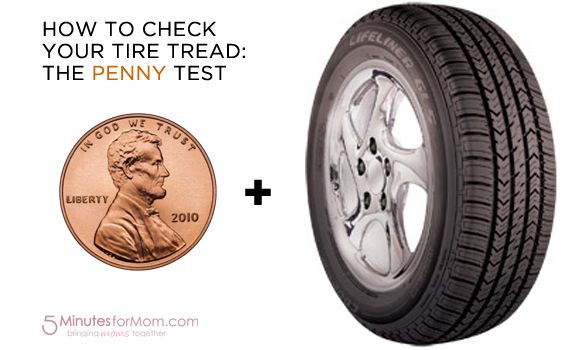When it comes to checking tire tread, there are a number of methods that can help you know if it’s time to replace a tire. Heavily worn tread will prevent a tire from performing as designed and can lead to unsafe driving conditions. One of the simplest, most common ways to check tread depth requires nothing more than a penny and a few moments of your time.
In the United States, tire tread depth is measured in 32nds of an inch. New tires typically come with 10/32” or 11/32” tread depths, and some truck, SUV and winter tires may have deeper tread depths than other models. The U.S. Department of Transportation recommends replacing tires when they reach 2/32”, and many states legally require tires to be replaced at this depth.
The idea of the penny test is to check whether you’ve hit the 2/32” threshold. Here’s how it works:
Place a penny between the tread ribs on your tire. A “rib” refers to the raised portion of tread that spans the circumference of your tire. Tire tread is composed of several ribs.
Turn the penny so that Lincoln’s head points down into the tread.
See if the top of his head disappears between the ribs. If it does, your tread is still above 2/32” , If you can see his entire head, it may be time to replace the tire because your tread is no longer deep enough.
When performing the penny tire test, remember not only to check each tire, but to check various places around each tire. Pay special attention to areas that look the most worn. Even if parts of your tread are deeper than 2/32”, you should still replace the tire when any areas fail the penny test.
Consistent wear around the whole tire is normal, but uneven tread wear could be a sign of improper inflation, wheel misalignment, or a variety of other things. If you see uneven tread wear, you should have a technician inspect your vehicle.
A simple way to check your tire tread depth is by using a tread depth gauge. You can find tire tread depth gauges at your local auto parts store. There are many models available, but an inexpensive simple graduated probe gauge will work just fine. All you have to do is stick the probe into a groove in the tread and press the shoulders of the probe flat against the tread block and read the result. All gauges should measure in both 32nds of an inch and millimeters.
You can find tire tread depth gauges at your local auto parts store. There are many models available, but an inexpensive simple graduated probe gauge will work just fine. All you have to do is stick the probe into a groove in the tread and press the shoulders of the probe flat against the tread block and read the result. All gauges should measure in both 32nds of an inch and millimeters.
Another indicator of worn out tread already lives in your tires themselves. Every performance, light truck, or medium commercial tire comes equipped with indicator bars (or wear bars) embedded between the tread ribs at 2/32”. They’re there to help you monitor tread depth and make decisions about tire replacement. Just look to see if the tread is flush with the indicator bars. If they are, it’s time to replace the tire.
While the penny tire test does deliver on what it promises – indicating whether tread has reached the legal limit – it may not be the best indicator of whether your tires are safe for the road.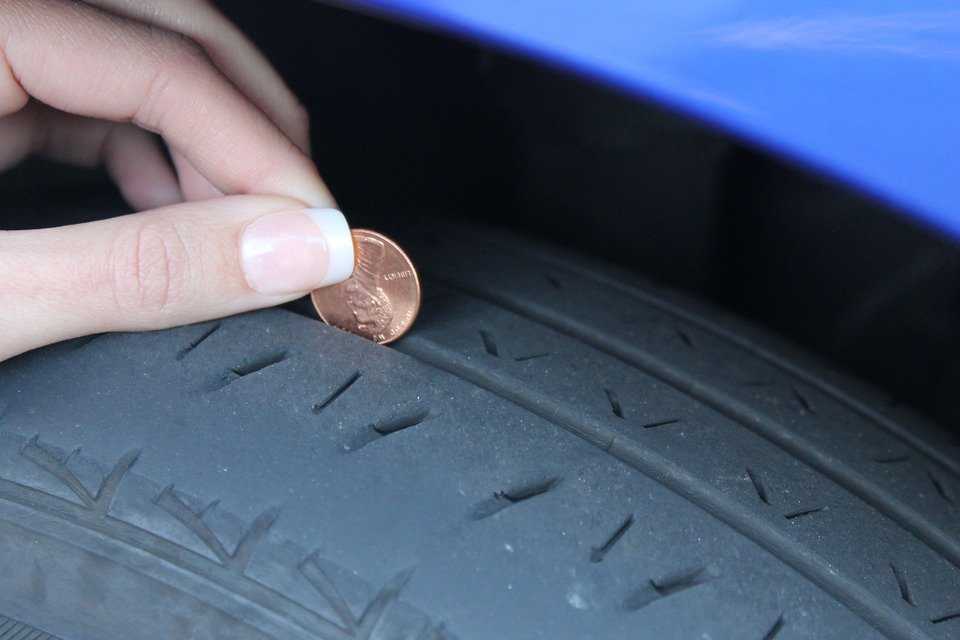 Tire performance can diminish significantly before your tread hits 2/32”. Even though the law deems fit for safe driving may not prevent you from hydroplaning or losing control in rainy, slushy conditions. If you think your tires may be close to needing replacement, have them checked out by a licensed mechanic.
Tire performance can diminish significantly before your tread hits 2/32”. Even though the law deems fit for safe driving may not prevent you from hydroplaning or losing control in rainy, slushy conditions. If you think your tires may be close to needing replacement, have them checked out by a licensed mechanic.
Calculate Out-The-Door Price
close
Tires
When your tire treads wear thin, you could be in for a slippery ride—literally. Luckily, you can spot dangerous tread depth using only a penny, and Honest Abe’s face! The penny test is quick, easy, and can help you know exactly when to replace tires.
To check your tread depth, you don’t need any fancy tools or expert knowledge. Grab a penny, and you have everything you need!
Grab a penny, and you have everything you need!
For reference, the distance between the top of a penny and Abe’s head is about 2/32nd of an inch. If you can see the top of his head, your tread is less than 2/32nd of an inch and your safety may be at risk. Depending on where you live, continuing to drive on such thin tread could actually be against the law.
"Most states require a minimum of 2/32 of an inch (approximately 1.6 mm) of tread, but two require less, some have no requirements, and some defer to the federal criterion for commercial vehicle safety inspections," reports the National Center for Biotechnology Information.
With adequate tire tread depth, your car is able to grip the road. This is especially important when roads are snowy or wet, or when you’re driving on less-than-ideal surfaces. Once tread becomes shallow, your tires are more prone to slipping and sliding, creating a dangerous situation for yourself and other drivers on the road.
When your tires are worn, other components of your vehicle can begin to wear prematurely, too, as your vehicle experiences excess strain. While new tires can be a big investment, they’re an investment worth making.
Reach into your pocket and pull out your spare change. Give the penny test a try—it only takes a few minutes—and find out if it's the right time to replace your tires. If you're short on change, just find your nearest Firestone Complete Auto Care. Our stores offer free tire inspections that include tire tread depth measurement!
Schedule
Tires
Aug 22, 2016
Tread wear, your tires exposure to the elements, and tire age may all be contributing factors to your needing new tires. Read on to learn how to tell.
Read on to learn how to tell.
Read More
Tires
Aug 22, 2016
Firestone tires create a whole new driving experience. Learn about the technology of our tires that improves driving on straightaways and handling ability.
Read More
Tires
Aug 22, 2016
Tires are an investment & you want them to last. Here are some tire care tips to help you get the most out of your tires & info on our free inspection
Read More
LOAD 3 MORE
SHOWING 6 OF 12
Tires
Jan 14, 2018
Wondering how to choose tires? Let us simplify the process into a handful of easy-to-follow steps, from Firestone Complete Auto Care.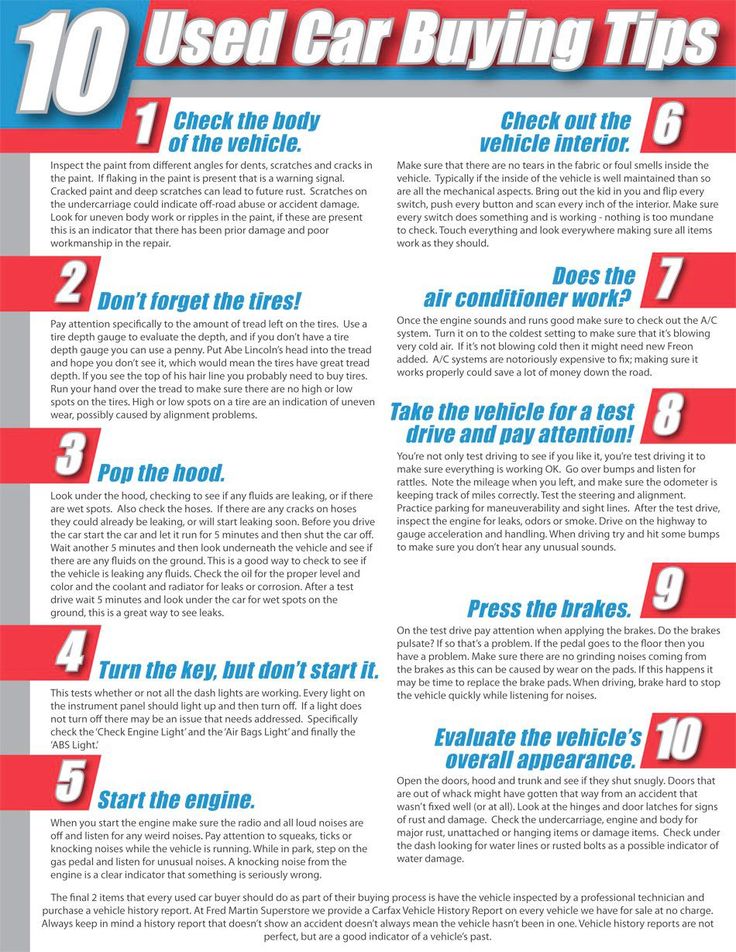
Read More
Tires
Jan 10, 2018
Do you need to switch all of your tires to winter tires, or will two do just fine? Get the answer, from the tire pros at Firestone Complete Auto Care!
Read More
Tires
Nov 30, 2017
Your tire wear patterns are talking. Are you interpreting? Check out images of common tire wear patterns from Firestone Complete Auto Care to learn how!
Read More
{{storeNumber}}
{{storeName}}
{{link-icon "Call Us" mobileCallLink null "call-cta"}} {{link-icon "Directions" directions "_blank" "directions-cta"}}
{{address}}
{{city}}, {{state}} {{zip}}
{{#if activeFlag}} {{#ifCond mystore "or" myPreferredStore}} {{#ifCond storeType 'eq' "TPL"}}
*Call store for appointment {{phone}}
{{else}} {{#if onlineAppointmentActiveFlag }}
{{#if myPreferredStore}}
{{else}}
*Call store for appointment {{phone}}
{{/if}} {{/ifCond}} {{else}} {{#ifCond storeType 'eq' "TPL"}}
*Call store for appointment {{phone}}
{{else}}
Schedule Appointment {{#if onlineAppointmentActiveFlag}} {{else}}
*Call store for appointment {{phone}}
{{/if}}
{{/ifCond}} {{/ifCond}} {{else}}
*Temporarily Closed Due To: {{temporarilyClosedReason}}
{{/if}} {{#if isMilitaryStore}}
*This location is on an active US military base. You may need military ID to access the location.
You may need military ID to access the location.
{{/if}}
{{#ifCond count 'eq' "3"}} Show More Stores {{/ifCond}}
The tread is a very important structural part of the tire, which indirectly and directly affects the safety of your trip. In order to be sure of your rubber, you will have to measure the residual tread depth a couple of times a season.
In order to determine the exact remaining tread in millimeters, you can use one of several measurement options. The easiest and most affordable option for everyone is to check the tread depth using wear indicators.
This method of measuring the remaining tread depth is accurate and simple, and most importantly, in this way any car enthusiast can find out the remaining tread of his tire.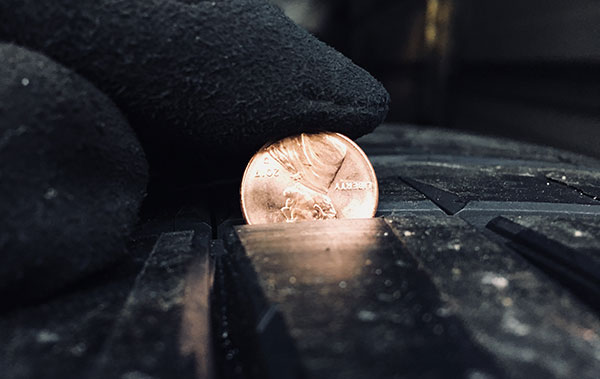
Tire manufacturers implement several indicator options: numeric and ribs. They have the same meaning and principle.
(example of wear indicators)
1) numerical wear indicator
of a numerical indicator of wear- these are different depths of the number on the tire itself. As the rubber wears, the numbers themselves disappear, showing you the remaining tread depth in millimeters.
As a rule, a numerical wear indicator is located on the tire tread. Looking at the tread, you will notice numbers arranged in a row, from 1 to 8. The last number is your tread depth in millimeters.
2) Rib wear indicator
The ribs as a wear indicator have the same principle as the numeric one, with one exception, they indicate the critical point in wheel wear at which the tire needs to be replaced to a new one.
If your tire wear indicator is on the same level as the tread, then it's time to change the tire.
(Examples of wear indicators)
3) Special gauges for measuring tread depth
If you have some mistrust of wear indicators on the tires themselves, then we hasten to please you. You can measure the tread height of your tire using specialized devices. These devices include the “tread gauge” and “caliper”.
These devices are either mechanical or electronic. However, there is no fundamental difference in the measurement algorithm or their accuracy.
(Electronic Tread Depth Gauge)
Anyone can measure the tread depth of your wheel with these devices. Below is a brief measurement algorithm.
The measuring part must be placed on the deepest point of the tread channel and the device will show you the residual part of the projector in millimeters. For a better understanding of the condition of the wheel, you will have to do this procedure in several places on the tire. This is necessary because the tire, in some cases, may wear unevenly.
This is necessary because the tire, in some cases, may wear unevenly.
How to evaluate tread wear?
You have taken the necessary measurements and know the remaining tread depth in millimeters. At what numbers can you drive further, and at what time is it time to change a tire?
For passenger car tires, a tread depth of 2 mm is considered safe. If your tire's tread depth is less than 2mm, then it's time to change your tires. (The “rib” wear indicator also measures 2 millimeters)
Please note that these figures are not recommendations. A tire with a tread depth of less than 2 millimeters loses stability on the road due to poor grip and water drainage.
(Table showing how the grip of a tire with different tread depth changes with increasing speed)
How to check the tread depth of a tire with a coin?
If it so happens that you don't have any measuring device at hand, then you should use the wear indicators on the tires themselves. The coin trick is too imprecise a measurement. And wear indicators are present on the tires of any automaker. Measuring the tread depth with a wear indicator is preferable and more accurate than measuring with a coin.
The coin trick is too imprecise a measurement. And wear indicators are present on the tires of any automaker. Measuring the tread depth with a wear indicator is preferable and more accurate than measuring with a coin.
From the same kind of myths as measuring the tread with a coin - “How to deepen the tread on a car tire?”. Safe, unfortunately not.
If your tire already has a wear indicator, then the remaining depth of the rubber coating to the cord is very small. It is impossible to drive safely on such a tire, and if you try to cut the tread, the tire will become unusable.
Total
As already mentioned above, monitoring the tread of your tires is an important feature of the safe operation of the car. Checking your tires for residual tread depth doesn't take long, but it can save you from a serious road traction accident. Fortunately, automakers help us monitor the wear process by installing wear indicators on their tires, which makes it much easier to check them for remaining tread depth.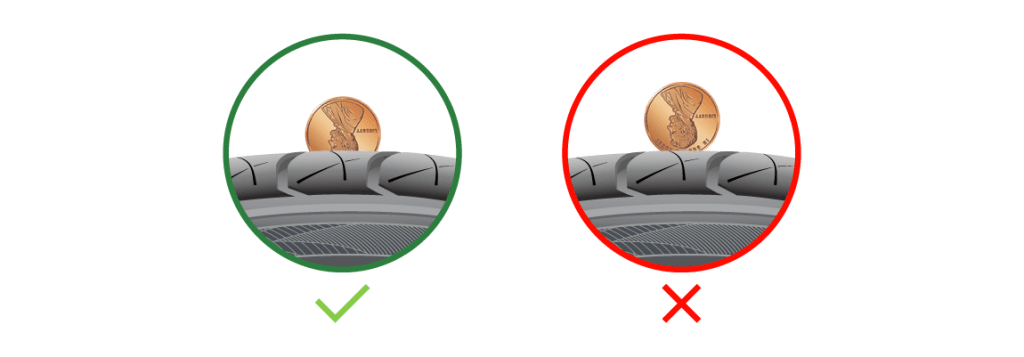 If you do not want to control the tread depth of your tires yourself, you can always visit a specialized service station, where mechanics will help you with all measurements. Safe roads for you
If you do not want to control the tread depth of your tires yourself, you can always visit a specialized service station, where mechanics will help you with all measurements. Safe roads for you
Tire tread can affect the safety and performance of your vehicle while driving. While you may not think about your tire tread every time you drive, it's important to check to make sure your tires are in good working order from time to time. Ready to talk about tire tread depth? Let's dive in.
Tire tread depth is the vertical measurement between the top of the tread and the lowest groove. In the US, tire tread depth is measured in 32 inches. When tires are new, they have a tread depth of 10/32 to 11/32.
In the United States, tires are required by law to have easily recognizable tread wear indicators. As the tire tread wears out, it will eventually line up with the tread wear indicator. At this point, the tire should be replaced. There is too little tread left to provide traction. If the safety wasn't convincing enough, be aware that driving a car with bald tires is also illegal.
At this point, the tire should be replaced. There is too little tread left to provide traction. If the safety wasn't convincing enough, be aware that driving a car with bald tires is also illegal.
Minimum tolerance is 2/32 inch. This does not mean that tires are completely safe if they have 3/32 of the tread left. This is simply the limit at which you will not pass the state safety inspection. As the tread wears out, your tires become less and less safe.
When it comes to safety, your tires are literally where the rubber meets the road. Sufficient tread depth is essential for safe cornering and braking.
Low tire tread depth can spell disaster for your driving, including:
If you live in an area where it rains or snows frequently, consider changing tires when they reach 4/32 inches. With worn tires, there is a risk of hydroplaning on wet roads. This is when the tire is unable to direct water through the grooves. The car rides on the surface of the water, and does not touch the asphalt. Thus, the tires cannot respond to the steering system. If you've experienced this, you know how scary it can be. In icy or snowy conditions, the shallow tread depth makes it difficult to stop. You can also fish with your tail when accelerating, or sliding to the side when turning.
With worn tires, there is a risk of hydroplaning on wet roads. This is when the tire is unable to direct water through the grooves. The car rides on the surface of the water, and does not touch the asphalt. Thus, the tires cannot respond to the steering system. If you've experienced this, you know how scary it can be. In icy or snowy conditions, the shallow tread depth makes it difficult to stop. You can also fish with your tail when accelerating, or sliding to the side when turning.
There are also special requirements for driving in hot weather. If you are approaching summer and your tires are nearing the end of their life, keep in mind that hot roads wear them out faster.
Very simple. All you need to check tire tread depth is a penny. Insert a penny with Abraham Lincoln's head upside down. If Abe's top is visible, it's time for new tires. Tamara shows you how to do it in this video.
Be careful when measuring tread depth.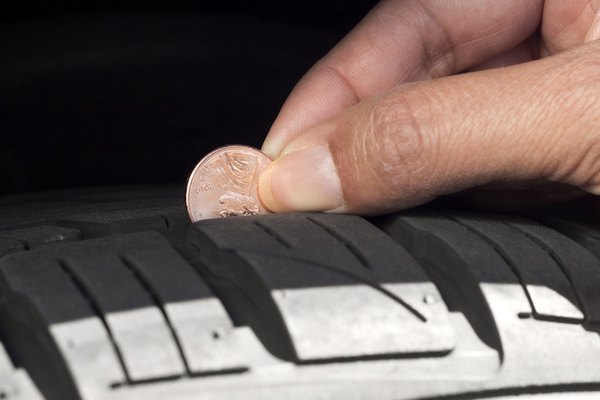 Insert a coin in several places around the tire. Uneven tread wear is not uncommon. Measuring in multiple locations compensates for this.
Insert a coin in several places around the tire. Uneven tread wear is not uncommon. Measuring in multiple locations compensates for this.
Correct tire pressure is also critical. Tire pressure is expressed as a number followed by PSI. This means pounds per square inch. 28 PSI means 28 psi. This is a measurement of the force inside the tire applied to one square inch. You can check the recommended tire pressure for your vehicle in your owner's manual or on a sticker inside the driver's side door. For most vehicles, this is around 32 psi.
If the pressure is too low, tires wear faster. You will also get leaner gas mileage. This is because it is more difficult for your engine to propel the car on soft tires. Low air pressure also results in a harsh ride.
If you find that your tires are too low, fill them up to the correct pressure. Don't think "the more the better".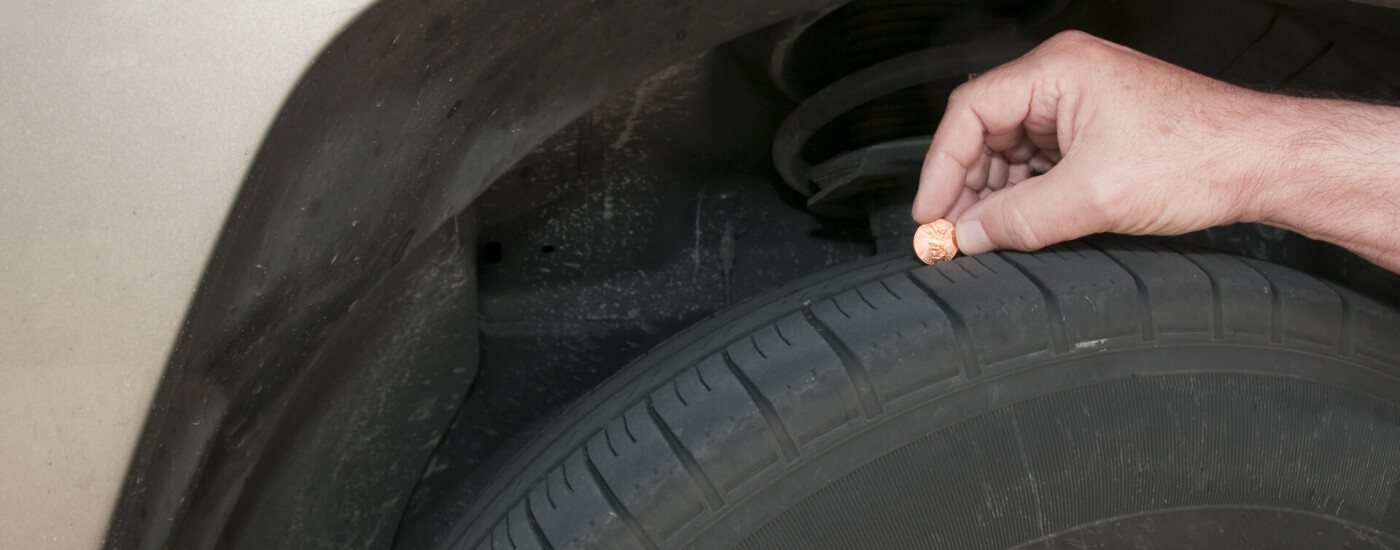 There are also problems with excessive inflation. When there is too much air in a tire, it has less contact area with the road surface. This complicates processing. It also increases the risk of a blowout. At high speeds, the blowout can be fatal.
There are also problems with excessive inflation. When there is too much air in a tire, it has less contact area with the road surface. This complicates processing. It also increases the risk of a blowout. At high speeds, the blowout can be fatal.
Since the early 1970s, the National Highway Traffic Safety Administration (NHTSA) and international colleagues have been concerned about the dangers of low atmospheric pressure. They were looking for technology that could alert drivers. Evidence was emerging that under-inflated tires were responsible for thousands of car accidents every year. At the end of the decade, NHTSA was also motivated by the energy crisis. Tire pressure affects fuel economy.
Tire pressure measurement technology became available in the 1980s and was first used by Porsche on a 1987 959 Porsche.
There are two types of TPMS: indirect and direct. Direct pressure sensors are located on the tire stems.